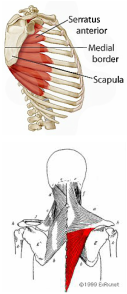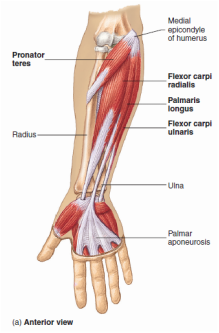 A conversation over on Facebook about warming up had me reviewing my post from waaaay back in February on warm ups. It reminded me that I was remiss in not emphasizing my love of working oppositional muscles to improve the balance of muscle pull on a joint. That means more pushing for all aerialists! Anyone who does that much pulling / hanging really should be doing some overhead pushing to balance out the muscles of the shoulder and surprise the stabilizers with forces in new directions. Acro / handbalancing / tumbler folks I recommend the exact opposite for you. How about giving hanging a try (with good form, please)? Overhead pulling is the answer for you. How should an aerialist get pushing? I'm a fan of training functional movements. So, how about a handstand (with good form, please)! Too hard? Try a downward dog. Somewhere between? Put your feet up on a increasingly higher supports, as you can maintain your shoulder control, until you are stacked and in an upside-down L shape with your hips over your hands. Don't forget! This is all about pushing, for you (wonderful) body nerds this is coming primarily from the serratus anterior. Keep your shoulder blades actively reaching away from your hips and your elbows feeling like they are rotating towards each other (as if you were trying to turn you thumbs to point forward from the shoulder). If you are a handbalancer working on pulling, hanging is all about proper form and getting the shoulder blades and humerus in the proper position. Your shoulder blade needs to rotate upward a full 60 degrees. Your serratus anterior is already super strong from all of your pushing. You'll be relying more on your lower trapezius to keep your scapula down on your back while helping with your scapula's upward rotation. Note the distinctions that these things should be done overhead. Our shoulder is a complex joint and the intricacies of the motion and stabilization of full shoulder flexion deserve and need extra love. For you body nerds check out this video, with a more full description of the movement and the movers at play coming soon.
0 Comments
The Circus Doc(tor) is in the houseCheck out our new sister website, The Circus Doc. It's a circus medicine website just for you!
Dr. Emily Scherb will present the latest research, trusted links to helpful information, new blog posts, training tips, information on upcoming workshops, and answers to all of your circus and movement questions. You can find the latest information available about your body in motion while in the air and on the ground vetted by a medical professional. How Much is Too Much? What the International Olympic Committee thinks about your training habits.9/14/2016 This month the International Olympic Committee (IOC) put out a consensus statement about "load management" and its relationship to major risk factors for injury in elite athletes. In my mind, performers are the ultimate athletes able to combine strength, grace, control, flexibility, artistic prowess, and explosive power all while managing performances, training, and the stresses (and joys) that come from creating art.
What is this load that the IOC is concerned about? Load, in summary of the IOC, is the combination of all sources of pressure on you comprised of those directly from your sport and those from outside your sport, including physiological, psychological, or mechanical stressors (ie lack of sleep, a busy schedule, preparing for a show, or going for a hard hike). These factors are considered over the short term (one training session or performance) and long term (months or years) and the variable magnitude of the factors (ie duration, frequency, and intensity)  f when you grab your aerial silks, trapeze, or rope and the inside of your elbow shouts with sharp pain, you could be suffering from “climber's elbow” otherwise known as medial epicondylosis. But, what exactly is going on and what can you do about it? That super tender spot on the inside of your elbow is the medial epicondyle. This knobby bump on the ulnar (pinky side) of the elbow where the common flexor tendon attaches the wrist and finger flexor muscles, and the pronantor teres to the bone. These are the muscles that you use to flex your fingers and grasp your apparatus, to turn your palms facing outward, like to grip a trapeze, and to bend your wrist toward the pinky side of the hand, as with vertical apparatus. So, basically, all the muscles we hang our entire body weight from. Often injury to this tendon is due to overuse, either from over training with too little rest, or from muscle imbalances in the body that make these muscles work overtime. Overuse and muscular imbalance is incredibly common due to how our lives revolve around finger flexion. These are the same muscles we use to type and use those '”wonderful” track pads on our laptops. Considering that not only are we aerialists, but also participants in the digital age, this gets tricky. Let's investigate the reasons behind why the hollow body is so important, when it is most useful, and how it is not always needed, and when to look out for injurious movements.
Who: Most aerial teachers start teaching their beginning students how to hang with “engaged” shoulders and a hollow body in their very first class. What: A (correct) hollow body position is identified by a slightly flexed (flattened) lower back with the rib cage drawn down which is stabilized with all four of the abdominal muscles. |
Dr. Emily Scherb
|
 RSS Feed
RSS Feed